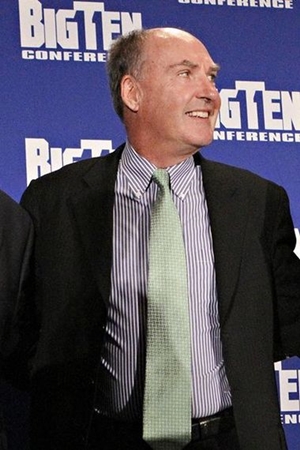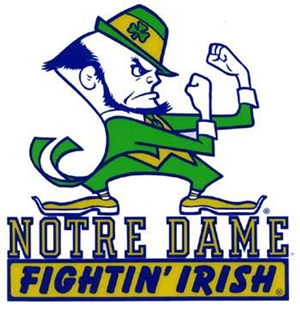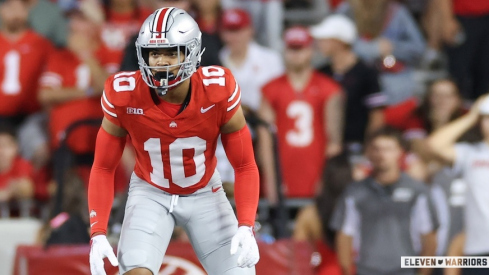Second-team All-ACC safety Earl Little Jr. transfers from Florida State to Ohio State.
 Does B1G Commish Jim Delany have something up his sleeve?
Does B1G Commish Jim Delany have something up his sleeve?Once a decade or so, the pragmatic Jim Delany comes out from his time-deprivation chamber to advance the plodding Big Ten a revolutionary step forward. Inexplicably, Delany then crawls back into his shell like a frightened turtle where the league hibernates for an indeterminate amount of time.
This cycle is as predictable as the day is long.
Last month, Delany took a small step forward – a large leap for Delany-kind – by offering his support for a prospective four-team playoff model that began percolating of heightened anticipation. He suggested, though, that he preferred a model that included higher-seeded teams hosting the semifinals.
B1G athletic directors emerged from meetings this week in Chicago with the league now staunchly against the idea and instead prefer to utilize BCS bowls. This turnabout could be a bargaining chip, the product of calculated genius. It also could be tomfoolery and caving to what Death to the BCS author Dan Wetzel calls the ‘bowl cartel.’
“For us, it’s critical to keep the Rose Bowl in the equation,” Michigan State AD Mark Hollis told reporters on Tuesday.
Twitter sensation Fake Dan Beebe responded most aptly yesterday when he tweeted, “direct Message to Jim Delany: I wish I knew 3 years ago that I could make you do whatever I want if I just called myself the Rose Bowl.”
It appears the cartel won, for now. But if this is just a thinly-veiled bluff, perhaps Delany should work on his poker face.
Much of Delany’s nearly quarter-century spent as the head of the Big Ten’s political machine has been directed with conservatism not seen since the formation of the Whig Party. When Delany’s Model-T gets to sputtering too loudly, though, the sand-bagging son-of-a-gun surprises us with some blockbuster that screams, “gotcha!”
Such was the case in 2007 when, against dire prognostications of industry experts, he spearheaded the launch of the Big Ten Network. Last month’s comments were a cursory step forward, but akin to a flat-earth believer finally confessing the earth is round.
Maybe Delany was merely opining when he came out in support of playing semfinal games on home sites. However, before going on record, you can wager any amount you’ll blow on today’s Facebook IPO that he wouldn’t make such proclamations without support of his conference constituents.
It well could be the work of a tactical ploy; a Jedi mind trick.
In Star Wars, Obi-Wan Kenobi and Luke Skywalker arrived in Tatooine with their droids looking for an experienced pilot. When imperial storm troopers showed up suspicious of the droids, Kanobe swiftly used the mind trick to get out of a sticky situation.
“Let me see your identification,” a trooper demanded of Luke.
“You don’t need to see his identification,” Kenobi said to the trooper, gentling rotating his palm toward the trooper.
“We don’t need to see his identification,” the trooper acquiesced before giving in to further sorcery, “you can go about your business.”
This kind of manipulation might work on the non-AQ conferences, or the equivalent of Tatooine rent-a-cops like, apparently, the ACC’s John Swofford, but one wonders if such a ploy will work on Delany’s arch nemesis, Mike Slive.
Unlike Swofford, Slive has equal or greater clout than Delany. His conference, the SEC, is the only one that can go toe-to-toe in revenue mentioning nothing of the many trophies they’re amassing when Alabama isn’t breaking them.
These mind tricks won’t work on Slive. Nor did they work on Jabba the Hut when Luke tried it in Return of the Jedi.
Skywalker returned to Tatooine to save Han Solo and Princess Leia from Jabba’s palace. To force entry and confront Jabba, he uses the mind control tricks taught to him by Kenobi on the guards. Jabba, though, is too wise to be influenced and is furious at the unsuspecting guard.

“You weak-minded fool! He’s using an old Jedi mind trick.”
Slive is the only match for Delany, the gatekeeper of major college football. Perhaps Swofford’s sudden support of a Delany-backed plan to have only conference champions in a playoff system is anecdotal evidence Delany is having his cake and eating it too; staying slaves to BCS bowls and using the semifinals as leverage toward the champions-only model. Slive has publicly admonished such a proposal.
What’s the endgame here? What’s up Delany’s sleeve? Perhaps the same object of desire as has been for 20 years: Notre Dame.
The B1G’s flirtation with the Irish has long passed the point of desperation. It’s the pimply-faced teenager that asks out the head cheerleader to every homecoming and prom for four years, though constantly being rejected. That would be noble persistence, except now he’s asking out the homecoming queen after she’s had three kids, put on 40 pounds and is living off food stamps.
An all-champions’ playoff would be Notre Dame’s death knell associated with an already-weakened Big East. It would mean losing their privileged BCS existence they’ve enjoyed for two decades as an independent.
One hopes this is the case otherwise their expansion motives are suspect.
Adding Nebraska to the fray has been a net positive for the conference. With the minor exception of the whole Legends-Leaders snafu, the transition has largely gone without a hitch. But while expanding just to expand doesn’t make sense, eye brows were raised when the B1G let Missouri run off to the SEC without even so much as a, ‘hey, can we talk?’
A super-conference model has been the clear destination for college football since expansion exploded two summers ago. Accordingly, despite the Big Ten’s lust for Notre Dame, it never made sense not to have viable backup plans for members 14-16.
In Delany’s delusions of grandeur, he has been doing the Texas two-step with the Longhorns while promenading with the Irish. The Big 12’s newfound stability seems to suggest the possibility of a shotgun marriage between Texas and the Big Ten has been all but swallowed whole by Bevo himself.
Last week, the conference agreed to a new 13-year deal with ESPN/Fox that is worth a reported $2.6 billion. The deal also reportedly extends the league’s grant of rights, which means if any team were to leave for another conference, money paid by those networks to the departing team would be forfeited to the Big 12. This leaves the door slightly ajar for Texas and the Big Ten, but more on that in shortly.
The Big Ten can snap its fingers and solicit an application from Rutgers on command. Finding other (qualified) candidates might be a bit tricky.
The most oft-mentioned targets have been Maryland, Connecticut and Georgia Tech. When the ACC voted last summer to increase its buyout provision to $20 million, reportedly Maryland and Florida State were the only two schools to vote against the measure. An East coast expansion including Maryland, Connecticut and Rutgers could be a feasible scenario for the Big Ten if or when the Irish commit.
The ball, though, is in the court of Notre Dame.
Delany can afford to wait them out a little while longer, as the conference media rights with ABC/ESPN don’t expire until 2016. Letting a decent addition like Missouri go without a fight, though, seems a bit risky especially if the Domers bolt for the ACC.
The ACC is thought to be a legitimate possibility for Notre Dame if they abandon independence. But two recent developments have Delany assuredly smiling: the mediocre deal signed by the ACC this past week with ESPN and the subsequent anger expressed by Florida State over the league’s direction, or perceived lack thereof.
Reportedly the deal will net the ACC $17 million per school per year on average over its life through 2027 – a $4 million increase. The stunning revelation, though, is this increase won’t be realized until nearly nine years into the deal. This was the extension that was triggered after adding Syracuse and Pittsburgh.

With an FSU trustee going full Mark Cuban-mode this week and openly acknowledging they would explore the Big 12, the ACC is suddenly looking both unstable and unattractive financially to Notre Dame. Former trustee Derrick Brooks doused the flames further this week by adding the Big 12 has contacted the Seminoles. If Florida State and/or Miami left, setting off departures by Georgia Tech, Maryland and others, the ACC would assuredly be checked off Notre Dame’s real estate watch list.
Meanwhile, the Big Ten is set up for a windfall of gargantuan proportions.
The B1G’s biggest ally in 2016 is going to be supply and demand itself. In 2009, Comcast purchased NBC Universal from General Electric and last year acquired sports network Versus with the idea of rebranding it NBC Sports Network. The goal was to go mono-y-mono with the Worldwide Leader in Sports.
So far, NBC has only added lightweights Ivy and Colonial to its college athletics inventory. With the SEC signed with ESPN through 2024, the Pac-12 and Big 12 with ESPN & Fox through 2025 and the ACC through 2027, the Big Ten is NBC’s only hope of landing a big fish for the next decade. The courtship of the Big Ten is about to become bigger than Brad and Angelina.
Comcast will give the moon to the Big Ten to land its tier-1 rights. It has to if it wants to be seen as a legitimate competitor. NBC already holds the rights to Notre Dame, which expires after 2015, so a Big Ten-Notre Dame merger would be ideal.
NBC could offer the league an unobstructed doubleheader for football and basketball, a tripleheader on NBC Sports and tier-3 games remain on the Big Ten Network. Delany’s craving for maximum exposure would be served with a Comcast deal, as they could be the lone major tenant for nearly a decade.
Even if Comcast struck out with its bid, the mere leverage should force ESPN to pony-up dearly.
Going to NBC could also allow for a loophole that allows Texas to bolt for the Big Ten, should the sneaky horns get bored with the restructured Big 12. The grant of rights deal would apply to ESPN/Fox, which has rights to every other major conference, but if the Big Ten left for Comcast, it's believed the grant of rights would not apply. So theoretically, the Longhorns could leave for the Big Ten without paying a penny.
Is this why Delany has been so coy? Perhaps not, but it is one plausible theory of the Big Ten’s contentment with 12 teams.
None of this guarantees this latest playoff concession is anything more than a public relations blunder. It does give hope though that Delany hasn’t gone deadbeat on us and he’s merely plotting his attack like a snake in the grass. The concession itself isn’t dire, but it’s strange to say the least.
There aren’t many other explanations for why the Big Ten has backed off its desire of having teams host the semifinals; certainly not many good. Notre Dame, carrying extra baggage since high school as she might be, would still be marrying up for the Big Ten.
Ignoring Missouri removes what would have been a nice secondary option with or without Notre Dame. Though the Irish aren’t the powerhouse they used to be, they and Texas are the only two possible home runs the Big Ten can hit. Now, if the league is looking to score, it must entrust its expansion plans to either the virgin pledging lifelong conference abstinence or the two-timing harlot that would sell its body to the most available suitor.
This latest obstacle might not be an unprecedented foray for calculating Delany. He is, though, dealing with the only people in athletics that know how to manipulate as well as he does.
Is all of this part of a master plan? God be with the Big Ten if it isn’t. It would be back into Delany’s shell for 10 more years.

